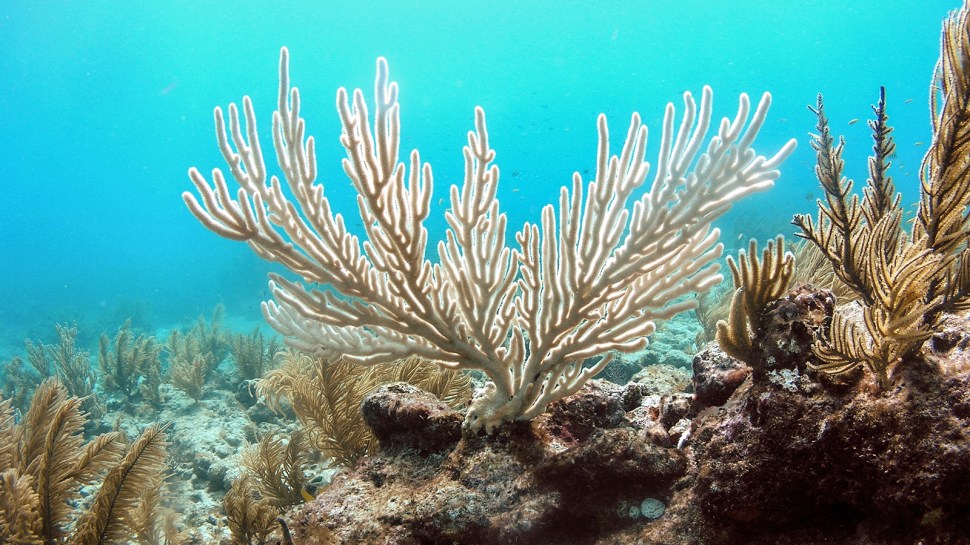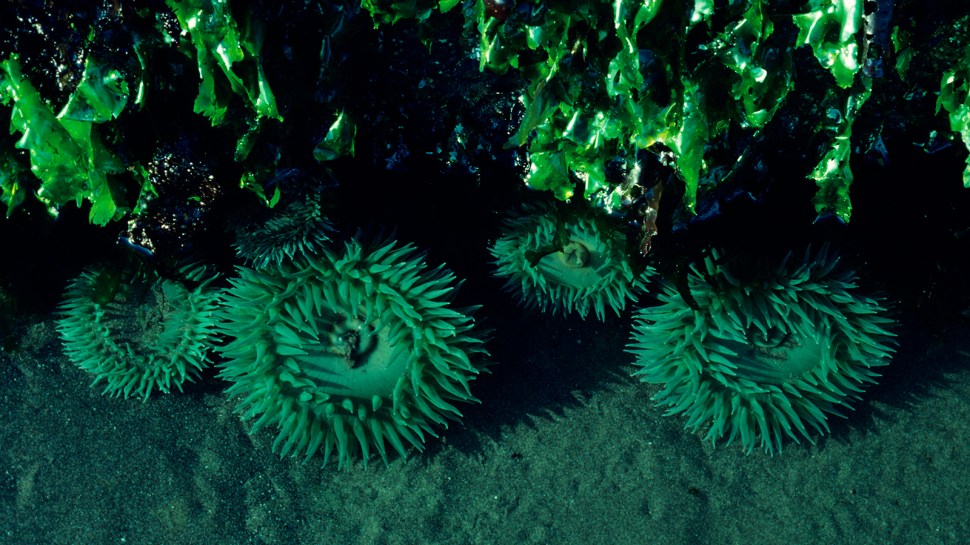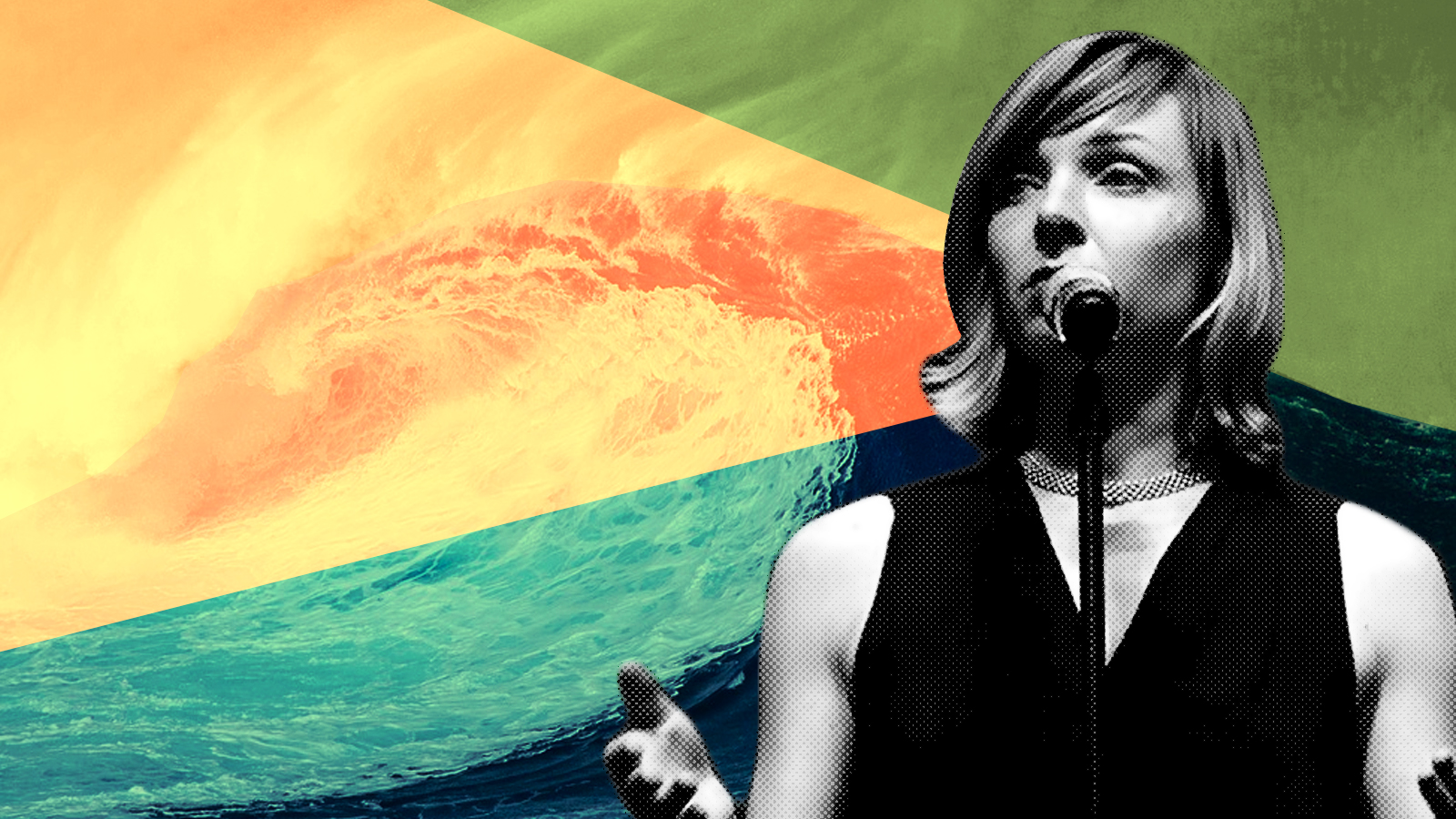In 2015, a University of California, Davis researcher named Sarah Moffit appeared in a four-and-a-half-minute video detailing her work studying ancient ocean ecosystems.
Looking young and serious, with a long ash-blonde mane falling around a scarf that wouldn’t be out of place on a Nancy Meyers protagonist, she explained the methods she used to make a new and significant discovery. First, she had sliced up cores of sediment from the ocean floor “like a cake.” Then she’d used a microscope to examine high-resolution photos of the microorganisms scattered throughout those samples.
Moffit’s analysis indicated that when an ocean ecosystem had suffered an ecological shock — such as relatively sudden shifts in oxygen levels or temperature — it had taken 10 times longer to recover than was previously believed, millennia as opposed to centuries. In other words: Climate change’s impact on marine life could be much more drastic than we thought.
“It’s a place of personal heartbreak to know that, in the future, if we go down a path of unchecked climate warming, these places that are so beautiful, these organisms that are so fascinating and bizarre and alien — that those organisms and those ecosystems will not be there for my grandkids,” she concluded, clearly crestfallen.
Three years later, in a coffee shop nestled in a damp alley just off the University of Washington campus, she tells me that video was one of her first forays into a debate that is currently raging in climate-scientist circles. At the time, she recalls hearing a rumble of disapproval from some of her UC Davis colleagues along the lines of, “That’s not how a scientist should talk.” Scientists shouldn’t bring emotion or family or humanity into their work, they argued. It’s unprofessional! It’s irrelevant! And, of course, it’s feminine.
Today, Sarah Moffitt is Sarah Myhre, having reclaimed her maiden name after shedding a marriage, a foot of hair, and much of the timidity of her younger self. Now 35, she is known for much more than her work as a research associate at the University of Washington’s School of Oceanography. To her allies, the single mother is a passionate advocate for climate action and social justice whose voice reaches far beyond the staid confines of academia. To her detractors, she is a “climate alarmist.”
But the debate over the role scientists should play in public discourse goes far beyond Myhre. It strikes at the heart of what it means to be a scientist in the age of Trump. As the world watches the U.S. government withdraw from the Paris Agreement and extend lifelines to the coal industry, many in academia are asking: Should climate scientists be publicly advocating for climate action?
While traditionalists caution loudly against damaging one’s credibility by opining about what is, at heart, scientific phenomena, a new breed of scientist believes that it has a social and moral obligation to save the planet. These upstarts feel that it would be a violation of the social contract to not translate the severity of the climate crisis in terms the public can relate to and be moved by. They’re the descendants of scientists like James Hansen, who 30 years ago this week sounded the alarm on climate change to Congress — and eventually resigned his position studying warming at NASA to become an activist. And the traits that would typically stymie Myhre and her peers in the staid scientific arena, still dominated by male scholars in their ivory towers, may turn out to be their most formidable strengths in a highly politicized era.
“I think you can be both rigorous and objective and be human at the same time,” Myhre tells me. “And I have come to a place where I’m no longer willing to divorce my humanity from the science that I have participated in and am stewarding.”
One of the first meaningful occasions of a scientist stepping into — or rather, being pushed into — a public forum to advocate for climate action took place on the floor of the Senate in 2003. There, climatologist and geophysicist Michael Mann discussed his now-famous hockey-stick graph, which shows that recent changes in the Earth’s average temperature have no precedent in the prior millennium.
“When we first published our hockey-stick work in the late 1990s, I was of the belief that the role of a scientist was, simply put, to do science,” Mann wrote in his 2015 memoir, The Hockey Stick and the Climate Wars.

Mann at a 2006 congressional appearance. C-Span
He thought scientists needed to remain “dispassionate” in discussing their analysis of the climate, wringing empathy and emotion from their communication. But after his Senate appearance, he was the subject of a hacking attack by oil interests where his correspondence with other climate scientists was intentionally misrepresented. Once he realized the stakes involved, he says his feelings evolved. “Everything I have experienced since then has gradually convinced me that my former viewpoint was misguided,” he wrote in a 2014 New York Times op-ed.
Today, amid fake news and misinformation — and climate deniers eager to conflate uncertainty with doubt — Mann’s initial just-the-facts approach would not simply fail to win over hearts and minds, it’d be drowned out by bombast. But, according to Michael Nelson, chair of sustainable resources at Oregon State University, scientists are conditioned to be careful and to note that their conclusions could always require more research to back them up.
“We scientists start our sentences with, ‘It depends’ — because it does!” he says. “The world isn’t homogenous. It depends whether a tree grows in a mountain or a valley, for example — things respond differently. That’s drilled into our heads.”
In 2009, Nelson authored a definitive review of the arguments environmental scientists have used to advocate for climate action. In it he concluded, perhaps surprisingly, that his colleagues should become more active in policy matters.
He then expanded on that recommendation in a 2010 op-ed he coauthored in the journal Minding Nature: “Broad participation by scientists in advocacy will very likely make for a messy, complicated world,” he and a colleague wrote. “That complexity is justified if the goal is the betterment of society. It is time to stop discussing whether scientists should be advocates and move on to the difficult business of learning how to do so wisely.”

A colony of the soft coral known as ‘bent sea rod’, stands bleached on a reef off of Islamorada, Florida. Smith Collection / Gado / Getty Images
A few years back, as Myhre was pursuing her Ph.D. in paleoceanography at UC Davis, she realized that she ran into trouble when she tried to talk about science with the general public. Like most other scientists, she frankly wasn’t very good at it, having been drilled on precision, data, and careful interpretation. Public communication, however, required charisma, power, and clear translation.
Throughout her career, the global lack of action to slow climate change had become an increasingly alarming issue, so Myhre decided to sharpen her communication skills. She began to pounce on every course, conference, and any other opportunity to practice speaking publicly about science.
“Our respective discipline areas are so narrow and specific that when we talk as scientists, there’s only a small group of people that can really understand that language,” Myhre says. “That’s not enough. We can’t do this basic science and then just communicate with our little tiny microcosm and expect that we’ve completed our job.”
Many scientists argue that their colleagues must elide scientific uncertainties to portray climate change as an urgent threat and demand action. And yet even those critics usually agree that more must be done to fight climate change. At the same time, injecting those caveats into explanations can make for a message that’s less digestible to the general public. It’s a pickle!
“I’m not advocating for bad science at all,” Myhre says. “I’m not advocating for fudging information ever ever ever.”
Over the past year and a half, Seattle has played host to a public debate over the scientist-as-advocate question. The participants: Sarah Myhre and a local celebrity who happens to be her colleague at the University of Washington.
For the past decade, Cliff Mass, a professor of atmospheric sciences at the University’s College of the Environment, has arguably been Seattle’s most beloved meteorologist. Mass’ forecasts are so widely trusted that a common response to, “What’s the weather this weekend?” is “Well, Cliff Mass said it would rain!” In 2008, he started the Cliff Mass Weather Blog to share his love of weather with the average Seattleite. His inspiration was the teachings of his mentor Carl Sagan: “He really impressed upon me the importance of scientists speaking directly to people, not going through the media,” he says.
On a gray April day at the National Oceanic and Atmospheric Administration’s outpost in Seattle, a man — who, according to the event moderator, “doesn’t need much of an introduction” — approached a podium in front of a packed auditorium. Slight and soft-spoken, Cliff Mass has an unexpected charisma and command of a crowd. He grinned, and prefaced his talk with: “This will be a little controversial.” He then explained that there was little evidence that the series of devastating wildfires that dotted the western U.S. last year were influenced by climate change. That conclusion is in line with his rhetoric of recent years, which has tended to reject links between a growing list of natural disasters and global warming.
Mass believes it’s irresponsible to make a connection between climate change and extreme weather events without acknowledging the scientific uncertainties in that relationship. As a result, he is loathe to do so. (Extreme weather attribution is a fairly new science with substantial uncertainty, although the accuracy of those connections is rapidly improving.)
In February 2017, Sarah Myhre traveled to Washington’s capital, Olympia, to give testimony to the state House of Representatives Environment Committee. There, Representative Shelly Short, a Republican from northeastern Washington, asked her to comment on her colleague Mass’ unwillingness to link recent wildfires, droughts, and hurricanes to climate change. Myhre responded that she and many of her colleagues saw Mass’ recent views “as coming from a denialist or contrarian place.”
For Myhre’s part, she contends that communicating about climate simply through the lens of weather ignores a broader view. “This is not about warming or precipitation; it’s about ocean circulation, sea ice, distribution of glacial ice across terrestrial mountain ranges,” Myhre says. “When we talk about climate change, we’re talking about changing the biological, geological, and evolutionary trajectory of this finite planet forever.”
Mass insists that portraying climate change so breathlessly politicizes it — and that’s a detriment to bipartisan action on climate change. “Basically, what I’ve done is criticize some of the exaggeration and hype,” Mass says, defending his position. “And there’s some folks who believe that if you speak out against some of the over-exuberance and exaggeration, you’re a denier.”
This past October, Myhre once again took on Mass in an article in The Stranger, Seattle’s popular alt-weekly newspaper, criticizing what she sees as the consequences of his views: Namely, that he misses the human element, specifically the vulnerable communities who suffer the most from extreme weather events — and by extension, climate change.
“This is why communication about climate change is not about science inasmuch as it is about public service and public safety,” she wrote. “It’s about the lives of people and the places we call home. It’s about mitigating the risks of this planetary-scale self-inflicted wound.”
That op-ed kicked off months of back-and-forth between Myhre and Mass. There were accusations of incompetence and misogyny, on either side, in different Seattle publications. Myhre’s op-ed criticizing the appointment of Scott Pruitt in the Seattle Times elicited a comment from Mass (in the actual comments section) that she’s “idealistic” and “not really a climate scientist.”
Again Myhre penned a piece for The Stranger where she wrote that Mass perpetuates an institutional culture that “demeans women scientists.” Mass responded by effectively calling her a liar.
Myhre’s driving philosophy is that she cannot, as a woman, divorce herself from her humanity in the eyes of the scientific establishment, so why would she divorce it from the way she communicates with the public? She believes that she will always be seen as too sensitive or too angry or too sexy or too much of a bitch. These are simply the lenses through which society tends to view women. She is never seen as just a scientist — always a woman scientist.
That worldview emerges in a lot of her writing — which has appeared in The Stranger, Newsweek, and on her Medium blog. It covers a wide range of deeply personal topics: from the unprecedented heartbreak of divorce to the unexpected liberation of plastic surgery to the unspoken prevalence of sexual assault in scientific fieldwork. All of it is unapologetic in expressing the type of fuck-you feminism that has come into vogue post-Trump’s election.
It’s an approach that has not sat well with other academics. Take Judith Curry, who until recently was a climate scientist at the Georgia Institute of Technology. Curry very publicly left her position last year amid what she called “climate alarmism” that she said had taken over academia. In the wake of testimony Curry had given to the U.S. House’s Committee on Science, Space, and Technology last year — in which she questioned the effectiveness of environmental regulations and fossil fuel cuts — Myhre and others had labeled her a “climate contrarian.”
Curry lambasted the behavior of young, female scientists in a lengthy blog post last December that reads like a mix of Emily Post and the anti-feminist Phyllis Schlafly. In it, she labeled Myhre and her ilk as “radical lipstick feminists.”
“Is this category of female scientists particularly vulnerable to sexual harassment?” she writes. “Probably not. However, owing to their strident and often irrational behavior, they are very vulnerable to not being taken seriously by males in the scientific community and viewed as undesirable for faculty or other leadership positions.”
According to Myhre, women from Curry’s era believe that science rewards women for their humility and docility. “That’s a lie,” Myhre declares. “You’re not rewarded through docility, you’re subjugated.”

Sea anemones in the North Pacific Ocean off the coast of Washington. Karl Weatherly / Getty Images
Her words resonated as I watched a roomful of mostly older, white men interrogate her in April while she presented results from her research on ocean oxygenation in the North Pacific.
The scene was a lunchtime seminar on the University of Washington campus, where Myhre’s colleagues were swaddled in earth-tone fleece half-zips. Myhre, in a sleek, black skirt suit, had boosted her already considerable height with a pair of heels.
Myhre has published 13 academic papers on ocean oxygenation and led a team of paleoceanographic researchers who put together an unprecedented database of Pacific ocean sediment cores. Nevertheless, as her audience repeatedly interrupted her, she apologized more than once for “not being great at explaining this.”
“Despite its tremendous size, the deep North Pacific has received relatively little attention from paleoceanographers,” she said, beginning her talk. What followed was a scientifically rigorous discussion of oxygen shifts in the ocean that was basically impossible for me to follow. This is not, I kept thinking as I watched Myhre’s lecture and concurrent inquisition, a particularly engaging way to convey the crisis of a changing ocean to someone like me.
Of course, this presentation was not meant for someone like me — it was for her peers and colleagues. And this kind of interrogation is customary — no, necessary — to good, rigorous science. But this wasn’t supposed to be a Ph.D. defense; to my understanding, it was a friendly seminar.
At the dozenth interruption — about why she chose to make measurements in particular units, why she studied a particular time interval, whether she was familiar with other research — Myhre rested against the podium to answer yet another question in an even, thoughtful tone — but I thought I caught a sharp, momentary flex of her clenched jaw.
These days, Myhre has become a prominent figure in both women’s rights and climate advocacy circles. She liberally uses Twitter and Medium as platforms for her well-honed voice. She is a board member of both 500 Women Scientists, a very young organization that supports and promotes women in science, and Seattle’s Center for Women and Democracy. And just last month, in addition to her research position at the University of Washington, she founded The Rowan Institute, a communications consultancy for climate leaders.

Myhre at Seattle’s 2017 Women’s March. Courtesy of Sarah Myhre
A younger generation of scientists seems to find her approach quite appealing. In 2015, Priya Shukla, a soon-to-be Ph.D. candidate at UC Davis, was an undergraduate student in the same lab where Myhre conducted her doctoral research. She considers Myhre’s career a model for her own. She, too, is active in 500 Women Scientists. She, too, hopes to be as publicly and politically vocal as Myhre is about climate action and equity in science. She, too, has noticed how the overwhelmingly white and male power structure in the scientific community has kept certain crucial perspectives out of the conversation.
“We, the scientific community, have tried to view science as apolitical,” Shukla says. “Under the current administration, it’s becoming clear to young scientists and early-career scientists that science has never been apolitical. The fates of science and national and local and regional politics are all intertwined.”
This much is clear, as a fresh set of stale faces in the White House works to strip away a record amount of environmental regulations, resoundingly supports polluting businesses, and censors climate change references from government communications. These are not normal times — and the “normal” role of a scientist, it seems, may no longer be appropriate.
That was the theme of a TEDx talk that Myhre gave in early May in a sweltering auditorium at the University of Washington. The cavernous theater was packed, mostly with young students. Myhre was in heels again, her impressive stature noticeable even from the back row. Rather than running through the technicalities of her research, she spoke about her experience as a woman — a human — scientist.
Scientists are themselves galaxies of racial, social, economic, gender, sexual, and socioeconomic identities, Myhre told the audience. “And we are never separate from that humanity, we are always coupled to it,” she explains. “And we need to speak to this basic truth in public. Because if we don’t have the courage to stand up for our own humanity, how will we ever have the courage to stand up for the humanity of the people that science is meant to serve?”
Myhre closed her speech with a call to action. Do not check your humanity at the door, she pleaded. It’s an echo of the late climate scientist-advocate Stephen Schneider, who, according to his friend Michael Mann, once said, “Just because we are scientists does not mean that we should check our citizenship at the door of a public meeting.” (Schneider, coincidentally enough, was an influential mentor of Cliff Mass.)
The audience applauded, resoundingly, because that is the kind of sentiment that mobilizes people.
Because climate change, especially as Myhre sees it, is not a scientific problem but a human one. If it is solved, it will be with the help and innovation of scientists, of course. But first and foremost it will be solved by humans.






